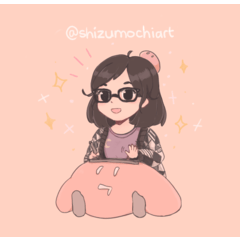How to create a waterbrush and use it on floral drawings
Hello everyone! I’m Qsan. Nice to meet you. Today I’ll show you how I created my watercolor brush and its applications. I hope this tutorial can helps to create the soft atmospheres of the traditional watercolor technique digitally. Let’s start!
1) How to create a new watercolor brush
Open Clip Studio Paint.
Go to File->New and create a new canvas [illustration]. I named it “Flowers”
The size initially is A3 format. 420 x 291 mm 350 dpi.
Go in to the Pen [Sub tool].
Duplicate the G-pen and rename it as you prefer. I choose “Soft Waterbrush”.
I used a simple pen because it’s clean from any specific setting.
This will make it easier to customize it.
Go to the Tool Property -> Sub Tool Detail Palette.
Here you can find all options to customize the brush.
Personally I edited it with these settings.
1) Go in to the Brush size and select “Specify by size on screen”.
2) Go to the Brush shape and change the “Pen” to “Pencil”. Click “Apply Brush shape”.
3) Go to the Brush Tips. Click “Material” and than click the white paper icon in the bottom right.
The program has already some basic materials available to use. Personally I added three of them: a Soft brush, a Blending Brush and a Blur Brush. After selecting a material, click OK in the top right of the dialog box. The pen will be more softer and irregular.
Go to “Thickness” and edit the cursor to 160.
The stroke will be wider and will emphasize the dynamism of the brush.
Go to the “Direction” option and set the value to 360.
Go to the “Brush Density” and edit the brush density to 40.
Deselect “Adjust brush density by gap”.
In this way the overlapping of different materials will be visible, creating lighter and darker areas.
4) Go to the Spraying effect. Activate the option and edit the “Particle size” to 100.
(Change this number considering the pen pressure you have)
5) Go to the Stroke:
From “Gap” -> select the Normal mode icon.
Select Repeat Method -> Reverse icon
6) Finally, go to the Ink.
Edit the opacity to 80
Click the icon next to “Color Mixing” and select the Blend option.
Edit the “Amount of paint” to 30
Edit the “Density of paint” to 5
Edit the “Color Stretch” to 7
These options help to mix colors like in a real painting.
The brush is ready to use!
if you want to change important settings without open again the property, click the eye icon next to each option. These will be added automatically in the [Tool Property].
[Gpen -> Soft Waterbrush]
2) Draw different Flowers
Let's start drawing our flowers.
Create a New Folder “Sketches”.
With the G-pen and blue color create some drafts. I did: poppies, sunflowers, hydrangeas and cherryblossoms.
If the size is too tight go on Edit-> Change Canvas Size-> Width from 420 to 800.
Create a Folder for each type of Flower and than
create a New sub-folder “Ink”-> New Layer in each folder.
Do the main lineart with the G-pen.
First to color them, add a New Layer “White base” to each folder created.
Select all drawings with Autoselect [Sub tool] -> Refer to all layers
Go to Selection Area-> Inverted selected Area
Color the selection with a random color, on each different “white base” layer.
This step is really useful to fill all unselected spaces.
[Before -> After]
For each layer Go to Edit->Tonal Correction->Brightness/Contrast.
Maximize the Brightness value to change the color to white.
3) Color flowers with custom watercolor brush created
Under the folder “Ink”, create a new folder “Colors” and add a new layer.
Start to use the brush we created making a color base.
Thanks to the low opacity, the color will gradually overlap with layers in Normal opacity 100%, creating more or less intense areas.
Clip to the folder below. The color will be locked on to the white base done previously.
This color process is repeated on all flowers, adding some contrast colors like yellow and blue in the same layer. For additional shades use the Blend brush, and to increase the color tone go to Edit->Tonal Correction-> Hue/Saturation/Luminosity
Above each “Ink” folder, create a new folder "Add". Here you can add small details and corrections, hatches and additional lights effect using the G-pen and Soft Watercolor brush tool.
[Before -> After]
[Before -> After]
If any changes require other blend levels than "Normal" blending mode,
Change the folder setting from “Normal” to "Through". In this way levels will have the same function but they are collected in a single folder.
[Before -> After]
[Normal -> Through]
[Before -> After]
Now all flowers are completed. Duplicate the main folder “Flowers” and merge each folder with “Convert Layer” into unique layers.
This allowed me to move the single piece in every position I preferred.
Once I created defined compositions, I added other small details like water drops and other little corrections.
And finished!
.
I hope you enjoyed this tutorial.
Flowers are amazing to decorate your characters.
I hope you will share your results the comunity.
Thanks for reading!
Qsan
Portfolio: qsanfolio.com
Deviantart: qsan90.deviantart.com
Pixiv ID: 3629457
Instagram: @qsanworks
Twitter: @qsanart
























留言